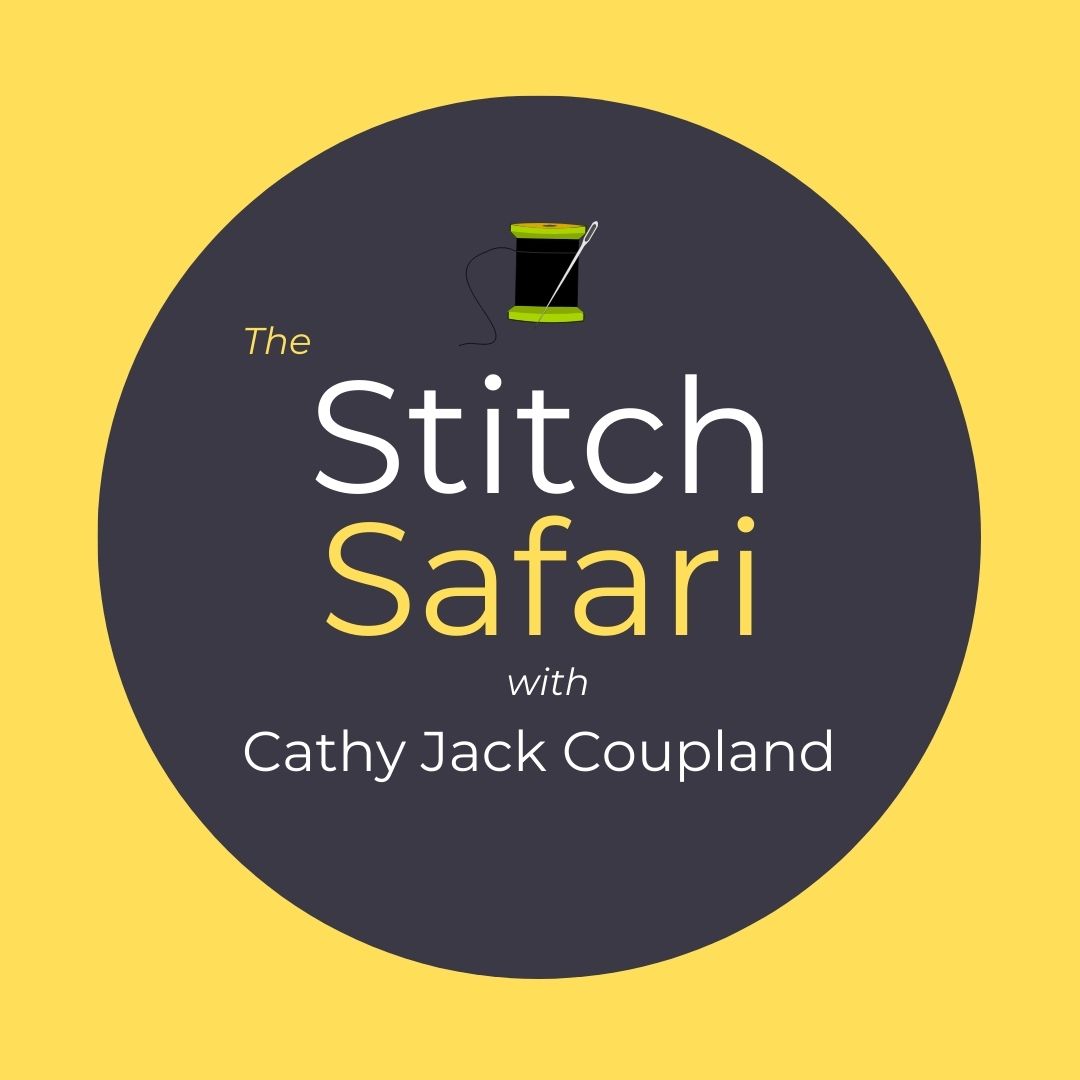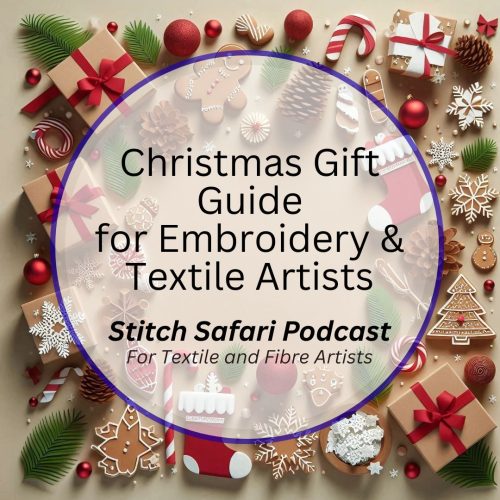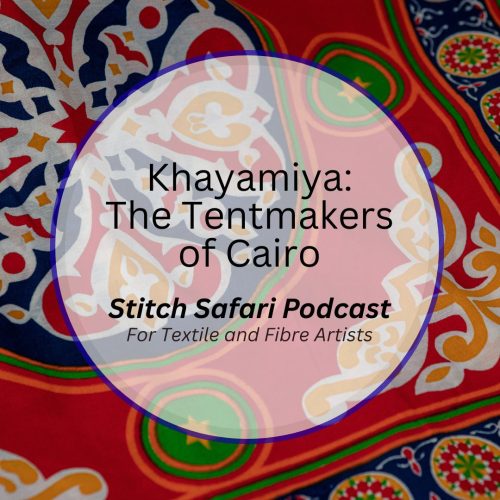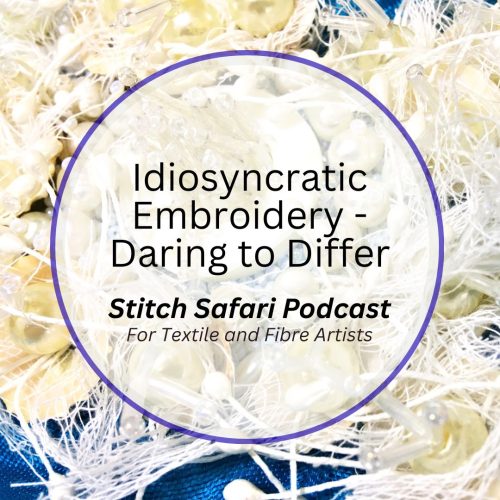In this episode of the Stitch Safari Podcast, I’m diving into the wonderful world of abstract embroidery.
This is one of the most fascinating and refreshingly freeing territories in the embroidery world, because it’s ever-evolving and in a constant flux of renewal.
I also believe it’s one of the most misused terms used to describe modern embroidery.
Most embroidery or textile art depicts recognisable objects or figures, but abstraction invites us into a very different yet highly engaging space, and I’ll tell you why.
It’s less about what we see and more about what we feel—and a lot of people find that space very frightening and off-putting.
Colours convey emotions, shapes become symbols, and lines tell stories that need no explanation.
This is a unique space where abstraction encourages us to look beyond what we see, to feel the artist’s expression of emotion and imagination formed by using fabric, techniques involving a needle and thread and a whole bucketload of intuition.
This can be incredibly freeing, allowing the artist to express their unique views, experiences, and interpretations through their artwork, and in doing so, evoke strong emotions and feelings in the viewer.
Suddenly, people are thinking about the viewer. It’s about time.
What does abstraction in embroidery mean? How do artists use stitches as their expressive tools? Who are some of the artists working in this arena of embroidery, and what ideas are they exploring? Finally, how can you begin to embrace embroidery in your unique creative journey?
Join me now as I explore this complex yet highly expressive world of abstract embroidery.
Let’s begin by understanding what abstract art and abstract embroidery are.
This is a style of art that does not attempt to represent an accurate depiction of a visual reality.
That’s the whole point.
And this is where it becomes confusing because so much textile and embroidery art is categorised as abstract, when, in my opinion, it’s not. It’s either naive, figural in a loose organic manner, stylised or pictorial, where figures and objects are depicted as figures and objects. True abstraction moves away from these depictions.
Abstract art uses shapes, colours, forms or gestural marks to create the effect or emotion the artist is looking for. That means that often, this style of art exists with a degree of independence from any, if not all, visual references.
To achieve abstraction, an artist relies heavily on those visual elements to create a composition; they become pivotal to the success of abstraction.
This space explores ideas and the unseen – things like feelings, moods and emotions, without relying on a literal representation.
Thus, the focus goes back to those formal elements.
When you really think about it, embroidery is the perfect vehicle for abstraction, because feeling is so often associated with touch, and embroidery is a hugely tactile art form.
The visual arts allow for that move away from direct representation, and yes, that challenges tradition, breaking free from the figurative or ornamental, resisting neatness and perfection to prioritise emotion, intuition and experimentation.
This is a world with different values, and that can be daunting.
Abstract embroidery, whether a minimalist mark or a riot of colour and stitch, prompts both the artist and viewer to form their own interpretation – to feel rather than see.
How many times have I heard the term thread painting? Not a term I like, but descriptive nonetheless.
Embroiderers use thread as an artist uses paint. Fibres become our drawing and painting tool to express, experiment and create textures that move our eyes across and around the work.
Think about that for a moment. We’re trying to evoke emotion and visual interest with a group of embroidery stitches.
This is a great exercise in expanding an embroiderer’s repertoire while inviting innovation and freedom.
How would you express chaos or intensity? Conversely, how would you interpret peace and calm?
The use of number comes to mind – using many randomly placed stitches evokes chaos, while using only a few suggests a far more peaceful interpretation.
What about colour? It certainly has a role to play. Vibrant warm colours shout intensity and chaos, while cooler colours or neutrals reference peace.
But wait, there’s more. What of form? A simple line can tell an emotional story all its own. Jagged, zig-zag lines immediately relate to a chaotic feeling, while smoother, gentler circles or curves emit a feeling of peace.
And let’s not forget the role texture has to play in helping to portray emotion.
Can you see how it all begins to come together? That story, that emotion or idea can be coaxed from those formal elements quite easily when you put your mind to it.
This then becomes your unique visual interpretation and personal language, just like your handwriting or the clothes you wear.
Adding repetition, rhythm, and variety helps create a sense of stillness, energy or calm.
These elements and principles of design then become the language of thread, able to infer emotion or movement.
Let’s take a moment now to highlight three artists whose work in abstract embroidery is noteworthy.
One of my favourite abstract embroiderers is Kristine Stattin, and she holds this place because her work alternates between machine and hand embroidery, where long, sweeping lines are layered and interspersed with tiny, tufted French Knots.
Just that one simple use of contrast adds visual interest and creates tension and intrigue.
Kristine says of her work: ‘My work is all about the process, being in and surrendering to the moment, embracing the unknown, not being attached to outcomes and expectations, and bringing the threads to life.’
Her work is bursting with colour and texture, evoking energy and movement with layers of machine threads leading the eye while smatterings of textural knots create the tension and angst between those orderly, sweeping lines. It’s a wonderful use of an intuitive yet mindful practice, where mistakes are embraced.
Visit her Instagram page or read about her work in a recent article by Grace Ebert in Colossal.
Another article by Grace Ebert, writing for Colossal, features Lindsay Gradolph, who works as Lindzeanne.
This is striking, dense embroidery motivated as a means of mapping herself and her world, and it’s a fascinating use of embroidery.
Why? Because Lindsay works with simple lines, shapes and stitches to express planes of colour and texture. Lindsay finds solace in her freehand embroidery practice, based on her interpretation of topography – the arrangement of the natural and artificial physical features of an area.
Lindsay says this of her work: ‘I like to think of each of my pieces as its own little universe, whether that be internal or external. Someplace unfamiliar but perhaps closer than we think.’
This practical hobby turned into a drawing practice. Using Sashiko threads worked into upcycled fabrics led Lindsay to experiment with different ways of filling a space or creating a design.
Patterns are rife and varied. Circular forms dance in different sizes, bisected by bold stripes.
Many of her works evoke the celestial and organic. To Lindsay, colours have personality. Shapes have weight and character, so when she’s working, there’s always a push-and-pull or the gravity that certain shapes and colours exude.
This embroidery is uniquely interpretative of simple abstraction done very, very well.
Now to something so completely different, yet utterly stunning. The work of Anne von Freyburg.
Kate Mothes, writing for Colossal, says of Anne’s work: ‘As if splashed onto the wall with a monumental brush, installations visualise fabric and fibre as gestural splotches of paint’.
The Dutch artist describes her work as textile paintings, where colours bleed into one another, then drip and extend to the floor.
This is visually exciting work, drawing on 17th and 18th century European still-life painting traditions of the Dutch Golden Age, mixed with the highly stylised exuberance of the Rococo, reframing the relationship between fine art and craft.
Anne’s work is sensual and feminine, highlighting unexpected associations between materials. These abstract compositions often reference blurred florals that drip, some to the floor, using a mix of glossy, prettily coloured fabrics that swirl in a dance of colour without fully mixing. The resulting shapes are sensual, beguiling and strange, writes Mothes.
With a theme she calls ‘commodity fetishism’, she taps into 17th-century Dutch floral fashion of the old still-lifes mixed with the economic speculation bubble that characterised Tulipmania of 1634-37, creating a body of work that is stunningly whimsical yet strangely alluring.
What do Stattin, Gradolph and von Freyburg have in common? They share a use of colour, line, form and texture to express their ideas and emotions. Add to that their sense of freedom and intuition. You can see it and feel it in their work.
Their work screams with ‘possibility’ and the power of intuition and process.
There’s a sense of freedom in every piece, and the work grows organically and intuitively while mistakes are embraced as part of the visual language. The final product is not as important as the experience of making.
These are personal, process-based, meditative art practices.
Yet one of the most magical aspects of abstract embroidery as an art practice is its openness to interpretation.
What one person sees, another may see the opposite.
Viewers are gently guided by the title, materials and even the scale of the work, or some artists may deliberately hold back explanation.
Abstraction invites curiosity – that’s its strength. You feel it first, then you begin to analyse why you feel it. That’s powerful.
It really isn’t as difficult as it seems, and I invite you to give abstraction a go.
Here are a few quick tips:
- Think of an idea, experience or emotion – or not if you prefer
- Use colour to set a mood
- Use value to create depth
- Use lines and shapes to convey emotion
- Use texture to create a variety of densities
- Work with contrasts of elements
- Add rhythm, repetition and variety
- Work big
- Begin
It really can be that simple.
This has been a wonderful adventure into abstraction – one of my favourite art styles and embroidery styles when done well. It’s a world where thread leads the way, and we just have to trust that thread.
Regardless of whether we’re drawn to the bold or the subtle, the structured or the spontaneous, abstract embroidery is a deeply expressive decorative tool for your art.
I hope this episode has inspired you to pick up a needle and thread so that you may speak from the heart, where no words and no images are necessary.
Just emotion, feelings and your interpretation of it all.
And that’s the utter beauty of abstract embroidery.





